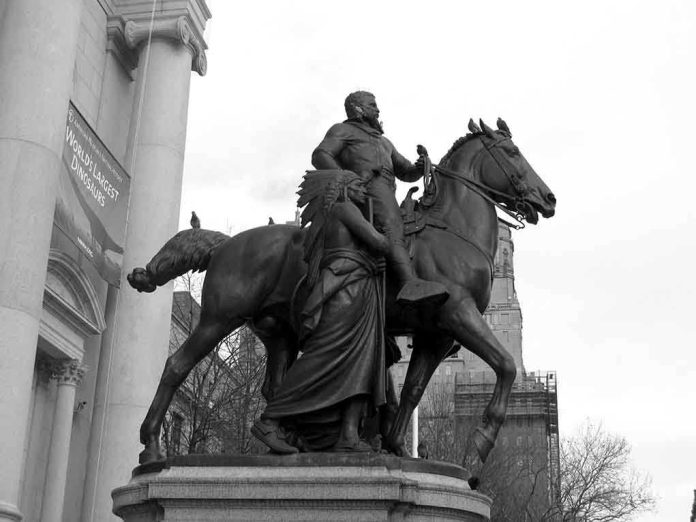
America has not finished fighting over its statues—because every stone and bronze figure is a battle flag in a much deeper war over who gets to write our history, and who must live with it in public view.
Story Snapshot
- The Trump administration has reinstalled the statue of Confederate General Albert Pike in Washington, D.C., five years after protesters toppled and burned it during the George Floyd protests.
- This move is part of a broader federal campaign to restore controversial Confederate monuments, including the Arlington memorial, reversing recent removals prompted by calls for racial justice.
- The action has reignited fierce national debate, with supporters citing historical preservation and opponents condemning the glorification of white supremacy.
- Key stakeholders include the Trump administration, civil rights groups like the SPLC, historians, local governments, and the Congressional Naming Commission.
Confederate Monuments: The Modern Battlefront
Washington, D.C.’s Judiciary Square again hosts the bronze likeness of Albert Pike, Confederate general, Masonic leader, and a magnet for controversy for over a century. The National Park Service, following an executive order from President Trump and policy guidance from Defense Secretary Pete Hegseth, completed the statue’s reinstallation in August 2025. This single act, seemingly about stone and metal, reignited a cultural and political firefight that has been smoldering since the end of the Civil War and flared up dramatically after the murder of George Floyd in 2020.
The restoration comes on the heels of a years-long campaign to remove Confederate symbols from public spaces—an effort that had accelerated after 2020, with more than 160 monuments and markers removed nationwide that year alone. The Southern Poverty Law Center’s database counts over 2,000 such symbols still standing as of 2024, signaling just how deeply these relics are embedded in the American landscape. The Trump administration’s moves are not isolated acts, but part of a declared policy to halt “erasure” of American history—an argument that resonates with some, but is viewed by others as a smokescreen for preserving tributes to white supremacy.
The Political Chessboard: Who Controls Memory?
Power over public memory is a perennial tug-of-war between federal authority and local sentiment. The Trump administration’s initiative to reinstall Confederate monuments, including the Pike statue and the Arlington memorial, directly confronts city councils, congressional commissions, and grassroots activists who have long argued for removal. The D.C. Council first petitioned to remove Pike’s statue back in 1992; their calls were ignored for decades, only ending when protesters physically toppled it in 2020. Now, the federal government’s reinstallation is both a literal and symbolic reversal—a flexing of national power over local will, and a signal to heritage groups and preservationists that their vision of history is back in favor at the highest level.
Yet opposition remains fierce and vocal. The Southern Poverty Law Center, civil rights leaders, and the Congressional Naming Commission all see the restorations as regressive and dangerous. “President Trump’s latest attempt to erase our history and restore Confederate memorials… is a blatant attempt to mask racism and white supremacy as patriotism,” said SPLC President Margaret Huang. Retired Brig. Gen. Ty Seidule, who helped lead the congressional commission that called for the Arlington memorial’s removal, described its planned restoration as “just wrong” and “the cruelest I’ve ever seen,” pointing to its origins as a Lost Cause monument erected in the Jim Crow era.
What’s at Stake Beyond the Statues?
These statues are more than historical artifacts; they are lightning rods for national debates about race, reconciliation, and the stories that shape our public spaces. Black and Brown communities, civil rights organizations, and many historians see Confederate monuments as enduring symbols of oppression—reminders that the Confederacy fought to preserve slavery, not some sanitized notion of states’ rights. For them, the statues’ return is not about heritage, but about the persistence of an exclusionary narrative that has long marginalized their voices in public life.
Supporters, including some veterans’ groups and heritage organizations, frame the restorations as a defense against “erasing history.” They argue that removing monuments is a slippery slope toward forgetting the past—good, bad, and ugly. Defense Secretary Pete Hegseth put it bluntly: “Unlike the Left, we don’t believe in erasing American history—we honor it.” This rhetoric, echoed by President Trump, has found a ready audience among those who see the wave of monument removals as a capitulation to “woke” politics and an affront to traditional American values.
Aftershocks: Protests, Policy, and the Future of Public Memory
The immediate aftermath of the Pike statue’s return has been predictably turbulent. Renewed protests erupted in D.C. and other cities, with activists decrying what they see as a step backward for racial justice. The $10 million allocated for the Arlington memorial’s refurbishment has not gone unnoticed by critics, who question the wisdom of spending public funds on restoring monuments many Americans find offensive. Legal challenges and policy debates are all but certain to continue as the 2027 return of the Arlington memorial approaches.
Long-term, the Trump administration’s monument campaign could set new precedents for federal intervention in local and state affairs—especially as future administrations grapple with the politics of public memory. Museums, historical societies, and legal experts will find themselves on the front lines of these disputes, tasked with navigating the fraught intersection of history, identity, and power. The battle over statues is far from over; if anything, the lines have been redrawn, the stakes raised, and the nation’s gaze remains fixed on the next move in this ongoing contest over who owns America’s story.
Sources:
SAN News: A Confederate statue was reinstalled in DC. What is the status of other ones?
The Week: Trump officials reinstating 2 Confederate monuments















